Franz Peter Schubert's family
Posted by Richard on UTC 2017-01-18 16:02
The 31st of January this year is the 220th anniversary of the birth of the composer Franz Peter Schubert. Not quite a spectacularly round number, but round enough for the purposes of this blog: we won't be around for a rounder one.
Here's a boilerplate start to a conventional biography entry for our birthday boy:
Franz Peter Schubert was born on 31 January 1797, the twelfth [thirteenth] child of the School Principal Franz Theodor Schubert and his wife Elisabeth (née Vietz).
Well, this kind of statement only makes sense to archivists and biographers. To Franz Peter Schubert himself it would sound very strange, because his view of his family would be completely different, as would be the views of his brothers and sisters and his step-brothers and step-sisters. Even father Schubert, Franz Theodor, the teacher punctiliously recording the entries and exits of his family down the years in his 'Family Chronicle', would probably find the statement an odd way of looking at things – quite misleading, in fact.
Refugees from the east
When the first child arrived there was, strictly speaking, no Schubert family. That child's parents, Franz Theodor Schubert (1763-1830) and Elisabeth Vietz (1756-1812), were not married. Their son was born on 12 April 1783 and registered as Franz Ignaz Vietz. He was handed in to the foundling hospital two days later, hung on to life for a couple of weeks then died on 27 April. The survival chances of a new-born in the hospital were slim: every contemporary disease had its representatives there and the circulation of the diseases among the little inmates was guaranteed by the lack of anything that we moderns would regard as even the most basic hygiene.
In the foundling hospital little Franz Ignaz had at least a flicker of a chance at life. The alternative would have been that popular Viennese institution, the sewers, which would waltz babies down to the beautiful blue Danube. For many decades the great and the good in the government had attempted to suppress this method of the disposal of unwanted infants. The decrees of the time contain repeated attempts to prevent it: punishments for the perpetrators (who were hardly ever identified), grids across open drains, special rules to be used in autopsies to determine whether the infant was stillborn, murdered in some way or simply tossed away. There was a no-questions-asked box discretely positioned outside the foundling hospital. Nothing worked, but then the great and the good had the money to solve their own indiscretions humanely. The poor and the unwed had to improvise.
Franz Theodor and Elisabeth did what they could with very limited means, which, however, did not run to a retrospective entry for baby Franz Ignaz in Franz Theodor's 'Family Chronicle'. The Habsburg bureaucracy recorded his birth and the baby's death – they wrote everything down – but the father allowed him to disappear.
There was an unusual age difference between Franz Theodor (19) and Elisabeth Vietz (26). Conventionally it should have been the other way round, of course. Assuming that Franz Ignaz was a full-term baby and applying some simple biological laws we can assume that they knew each other by August 1782. The story of how and when they met has to be for another time. It is a tale full of gaps and guesses involving Elisabeth's younger sister Maria Magdalena Vietz and older brother Felix, as well as Franz Theodor's older brother Karl, whom Maria Magdalena would eventually marry. Let's move on.
Mr and Mrs Schubert
Franz Theodor Schubert and Elisabeth Vietz married on 17 January 1785. He was 21, she was 28. On the marriage certificate, toyboy Franz Theodor declared himself to be 25, probably to avoid the need to supply written parental approval. Saying this shouldn't be taken to imply that his parents disapproved. It may have simply been a problem of getting the right paperwork to Vienna in time: at that time a postcoach in clement weather could be expected to take between 10 and 14 days for the one-way journey between Vienna and Neudorf, let's say a month for the round trip. At the moment we are in the dead of winter. The pair were indeed cutting it fine with the wedding: their first 'official' child, Ignaz Franz Schubert, must have been a visible presence at the ceremony. He made his appearance just over two months later on 8 March.
The haste may have been due to the need for the aspiring school teacher to display an impeccable lifestyle and blameless conduct. The schools of the time were firmly in the hands of the Catholic Church. Franz Theodor had his patrons and his protectors, but was still required to avoid any scandal if he were to have a career in education.
Now we can finally speak of a Schubert family: Mum Elisabeth, Dad Franz Theodor and baby Ignaz. Almost exactly a year after Ignaz, on 1 March 1786, a daughter was born: Elisabeth. Ignaz was only 11 months old at the time, so the enormity of gaining a sister was probably lost on him. Around June of that year they moved into Himmelpfortgrund 72, the school which Franz Theodor would run for the next five years.
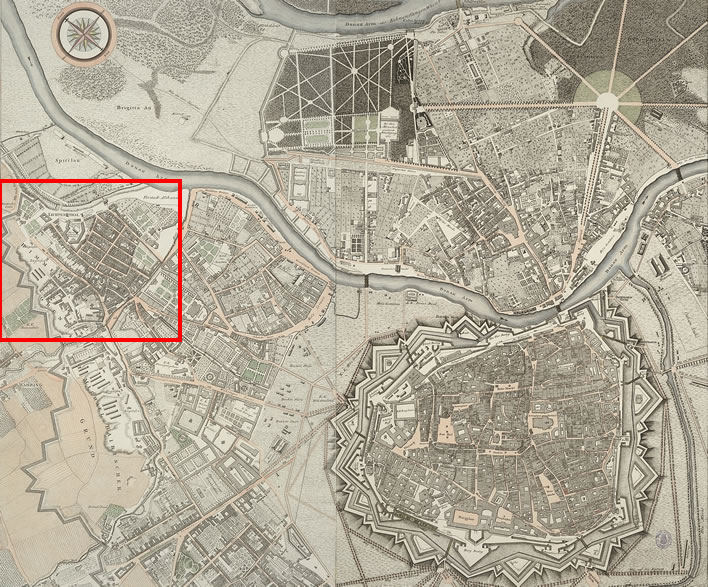
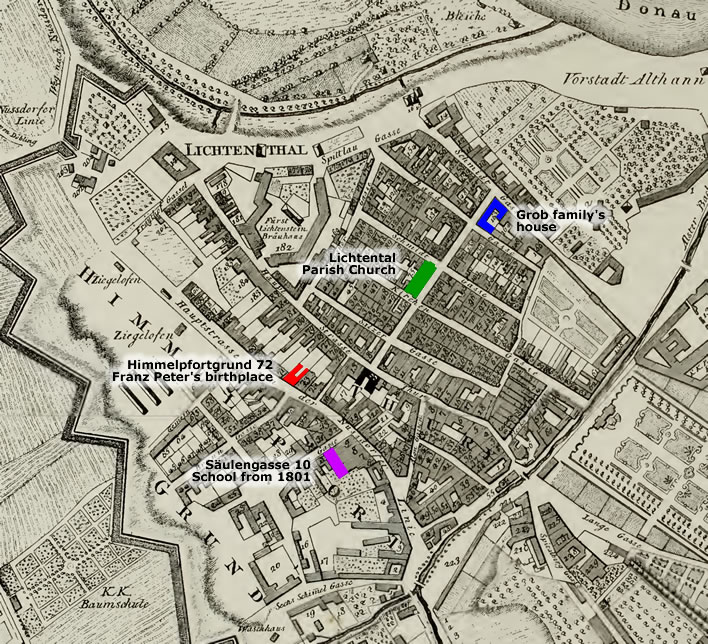
From the Plan von Wien und seinen Vorstädten, 'Map of Vienna and its suburbs', 1:4 000. Drawn by Maximilian von Grimm and engraved by Hieronimus Benedicti. Vienna, Artaria et Comp., 1797. (The year of Franz Peter Schubert's birth.)
Top: The first two pages of Grimm's map showing the city itself and the Vorort, 'suburb' of Liechtental, where the Schubert's lived at this time.
Bottom: The section of the map from within the red rectangle. Image: Deutsche Fotothek Online source.
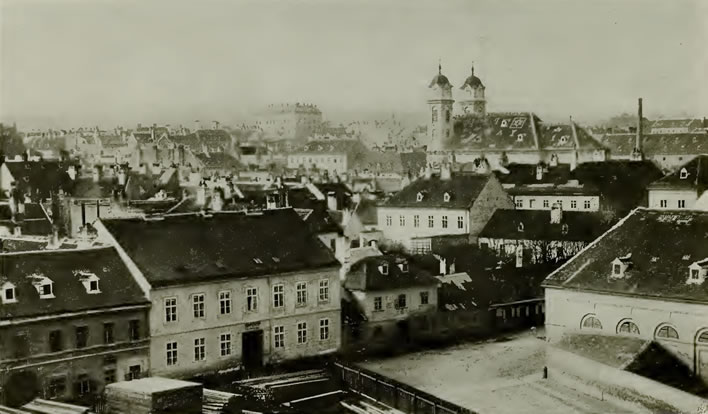
A photograph of Liechtental taken in 1868. The twin towers of the Liechtentaler Parish Church can be seen in the middle. Image: Albin Mutterer / Otto Deutsch / Gesellschaft der Musikfreunde Wien.
The vale of tears
A little over a year later a son arrived: Karl, on 23 April 1787. The Schuberts, Franz Theodor (23), Elisabeth (30) now had three children: Ignaz (2), Elisabeth (1) and the newcomer, Karl. This family bliss did not last long – it rarely did in these times – and 1788 turns into the family's annus horribilis. The first to go was Karl, only nine months old, on 6 February. Four months passed until the joyful arrival of Franziska Magdalena on 6 June. The Grim Reaper had not gone far, though. He returned and took little Elisabeth, the two year old on 13 August. Only one day later he then scythed down the two month-old Franziska Magdalena on the 14th. The causes of death are all different and all more or less meaningless to modern medicine: Karl, Wasserkopf; Elisabeth, Fleckenausschlag; Franziska Magdalena, Gedärmreißen. There is really no point translating this German medical mumbo-jumbo into English medical mumbo-jumbo. We only need to note that a school for young children in the infamously unhealthy Viennese summer was probably almost as effective as a foundling hospital in distributing disease. There was a reason the aristocrats left the city for their country seats.
Ignaz, three, was now an only child again.
Before modern medicine and hygiene, parents had to bounce back from such setbacks. Elisabeth had a couple of months respite before she became pregnant again: another Franziska Magdalena arrived, on 5 July 1789. The four-year-old Ignaz now had one sister. The Schuberts were a family of two children.
Almost exactly another year went by. On 10 August 1790 Franz Karl arrived, but he died after exactly a month, another summer baby, leaving the Schubert family at two children once more: Ignaz, then five, and Franziska Magdalena, then 14 months.
Another year passed. On 11 July 1791 Anna Karolina was born, but died only two weeks old on 29 July. The Schuberts, Franz Theodor (28), Elisabeth (35) now had only two children again: Ignaz (6) and Franziska Magdalena (2).
On 1 January the following year, 1792, Franziska Magdalena died, two and a half years old.
For the second time, Ignaz became an only child. The Schuberts had lost six children in under six years.
On 29 June 1792, about a year after Anna Karolina came and went, Elisabeth produced a little brother for Ignaz: Petrus. He would survive only six and a half months, dying on 14 January 1793.
Once more, Ignaz, now a seven-year-old, is on his own in the family. In this chronicle of misery and disaster this may be the moment for the parents reading this to take a little time to reflect on the human aspects of the Schuberts' situation at the beginning of 1793. How many times can the pious console themselves when the Lord taketh away quite so greedily as this?
A band of brothers
In the autumn of that year a brother for Ignaz arrived, Josef, on 16 September 1793. Almost exactly a year later, on 18 October 1794, Ferdinand Lukas was born, bringing the Schuberts back to a family of five: Franz Theodor (31), Elisabeth (37), Ignaz (9), Josef (1) and Ferdinand Lukas.
Another autumn, another baby: this time another Franz Karl on 5 November 1795. There were now four brothers in the family, with a big gap between the then ten year old Ignaz – the great survivor, who has watched his siblings come and go – and the three little ones.
A little over a year later, on 31 January 1797, 220 years ago, Franz Peter Schubert became the fifth brother. Ignaz was then 11 and had a cluster of four small brothers of three and under. This is the family into which the great composer was born. Franz Theodor (33), Elisabeth (40), Ignaz (11), Josef (3), Ferdinand Lukas (2), Franz Karl (1) and Franz Peter. All boys, one biggish one and four small ones.
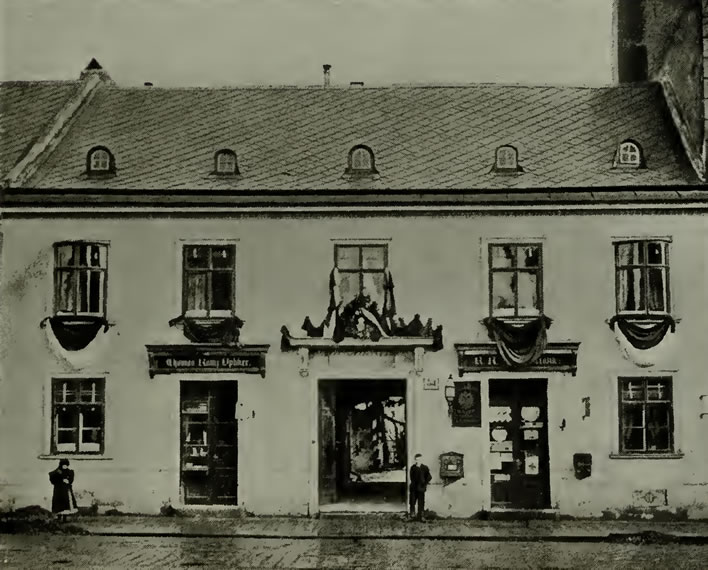
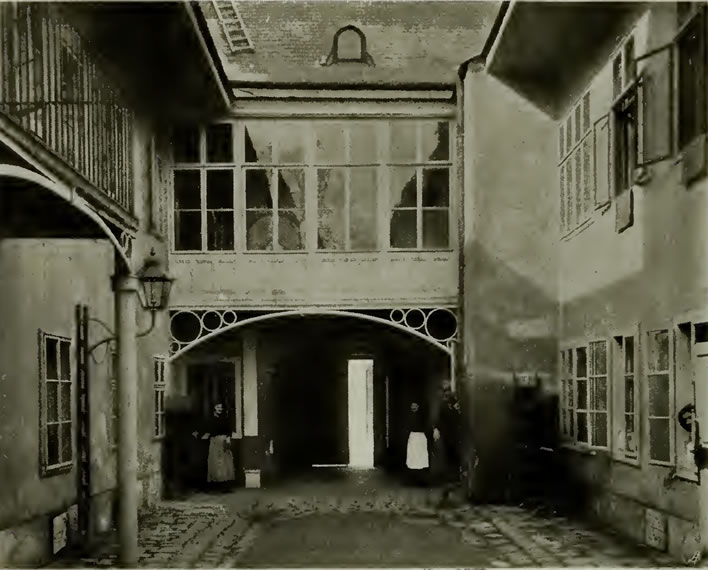
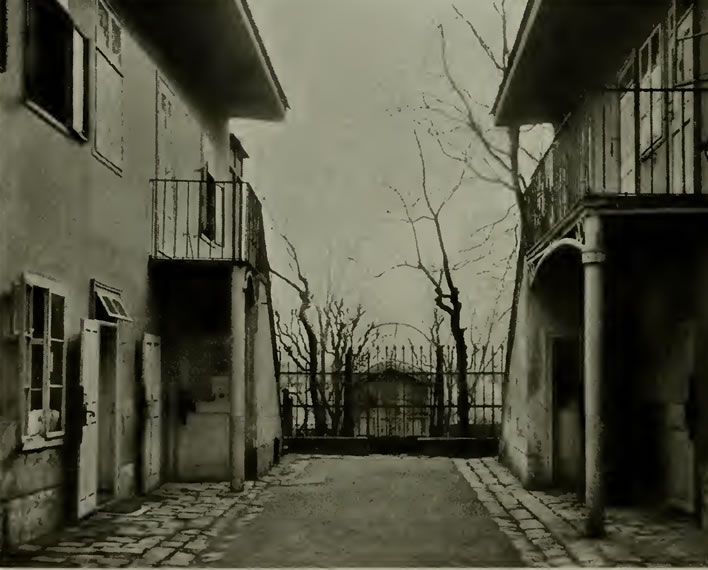
Zum roten Krebs, 'The House of the Red Crab', then Himmelpfortgrund 72, now Nußdorferstraße 54, the house and school in which Schubert was born.
Top: A front view photographed in 1897, the time of the first centenary of Schubert's birth.
Middle and bottom: The courtyard, seen from both ends.
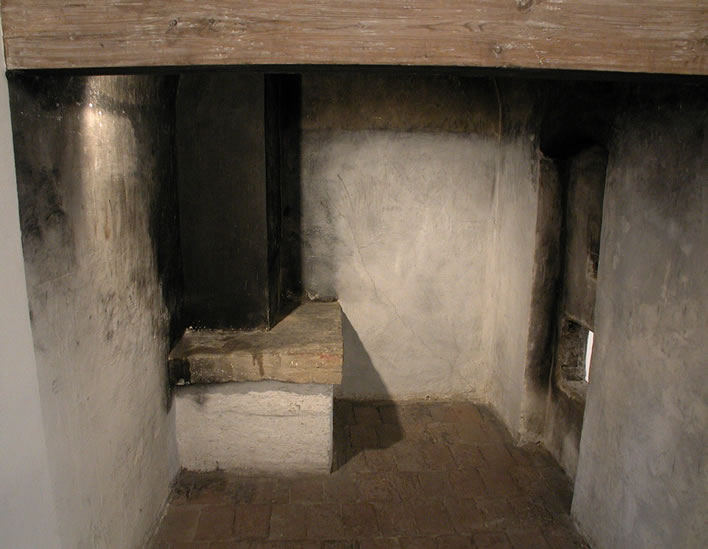
The kitchen in Himmelpfortgrund 72, supposed to be the place where Franz Peter was born. Image: In Mozart’s Footsteps.
This state lasted nearly two years, until 18 October 1798, when Josef Schubert, five, was taken from them. Franz Peter, not yet two, would presumably know nothing coherent about his brother Josef's death.
The family is now back to four brothers. A little over a year later, on 17 December 1799, Elisabeth brought a girl into the world, Aloisia Magdalena, but she departed again the next day. The Schuberts remain a family of six: Franz Theodor (36), Elisabeth (43), Ignaz (14), Ferdinand Lukas (5), Franz Karl (4) and Franz Peter (2).
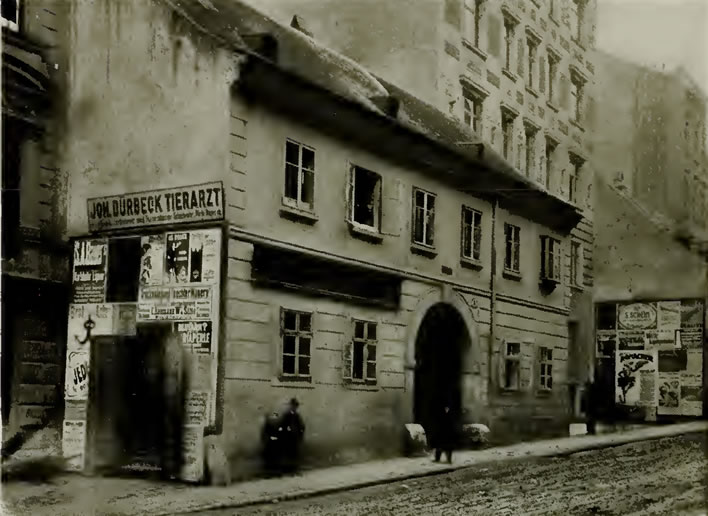
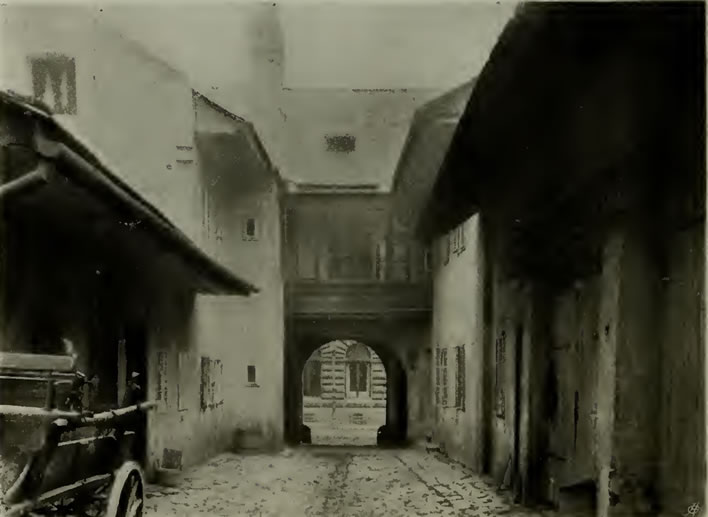
Zum schwarzen Rößl, 'The House of the Black Horse', now Säulengasse 3, originally Himmelpfortgrund 10. Franz Theodor set up a school here in 1810. Image: Albin Mutterer / Otto Deutsch / Gesellschaft der Musikfreunde Wien.
Around two years later, on 17 September 1801, the indefatigable Elisabeth produced another girl, Maria Theresia. It was no bad thing to have a patriotic name in the family in those troubled times. We might imagine the Schuberts thinking back to times before the repressive Franz II/I, times before the barely-there Leopold II and certainly times before the erratic Joseph II, times when Maria Theresia, the 'Mother of Austria' was at the head of the Empire. We are just speculating, of course, but for every Austrian her name radiated her legend. Besides, Franz Theodor had had three Maria Theresias as sisters, one of whom was still alive when the present one was born.
Elisabeth, now 44, was now – mercifully – babied out. She had eleven years of life left and would die on 28 May 1812 of typhus, the disease that 16 years later would take her great composer son Franz Peter away as well. At the time of her death the children were Ignaz (27), Ferdinand Lukas (17), Franz Karl (16), Franz Peter (15) and Maria Theresia (10). Four brothers and one sister. This was Franz Peter Schubert's family.
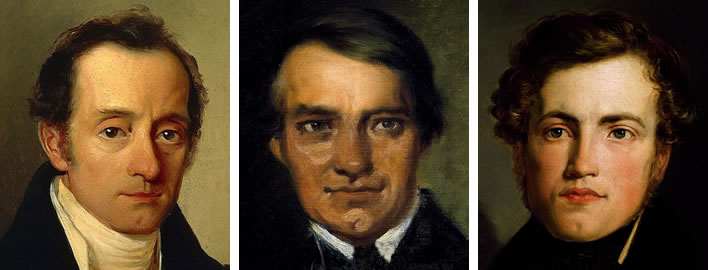
Franz Peter's three brothers (dates unknown). Left: Ignaz. Middle: Ferdinand, from an unfinished self-portrait – the 'Schubert dimple' was a challenge. Right: Karl. Image: Wien Museum, Schubert Geburtshaus, Nußdorfer Straße 54, 1090 Wien.
Summary table: the first Schubert family
| No. | Name | Birth | Death | Age | Remarks |
| - | Franz Ignaz Vietz | 12.04.1783 | 27.04.1783 | 2w | |
| 1 | Ignaz Franz | 08.03.1785 | 30.11.1844 | 59y8m | |
| 2 | Elisabeth | 01.03.1786 | 13.08.1788 | 2y5m | |
| 3 | Karl | 23.04.1787 | 06.02.1788 | 9m | |
| 4 | Franziska Magdalena | 06.06.1788 | 14.08.1788 | 2m | |
| 5 | Franziska Magdalena | 05.07.1789 | 01.01.1792 | 2y6m | |
| 6 | Franz Karl | 10.08.1790 | 10.09.1790 | 1m | |
| 7 | Anna Karolina | 11.07.1791 | 29.07.1791 | 18d | |
| 8 | Petrus | 29.06.1792 | 14.01.1793 | 6m14d | Sometimes 'Peter'. |
| 9 | Josef | 16.09.1793 | 18.10.1798 | 5y1m | |
| 10 | Ferdinand Lukas | 18.10.1794 | 26.02.1859 | 64y4m | |
| 11 | Franz Karl | 05.11.1795 | 20.03.1855 | 59y5m | |
| 12 | Franz Peter | 31.01.1797 | 19.11.1828 | 31y10m | The composer |
| 13 | Aloisia Magdalena | 17.12.1799 | 18.12.1799 | 1d | |
| 14 | Maria Theresia | 17.09.1801 | 07.08.1878 | 76y11m |
Surviving brothers Surviving sisters
This table is also appears in Before Schubert: Franz Theodor and Elisabeth's children. where the topic of Franz Peter's immediate family was briefly discussed in another context.
The second Schubert family
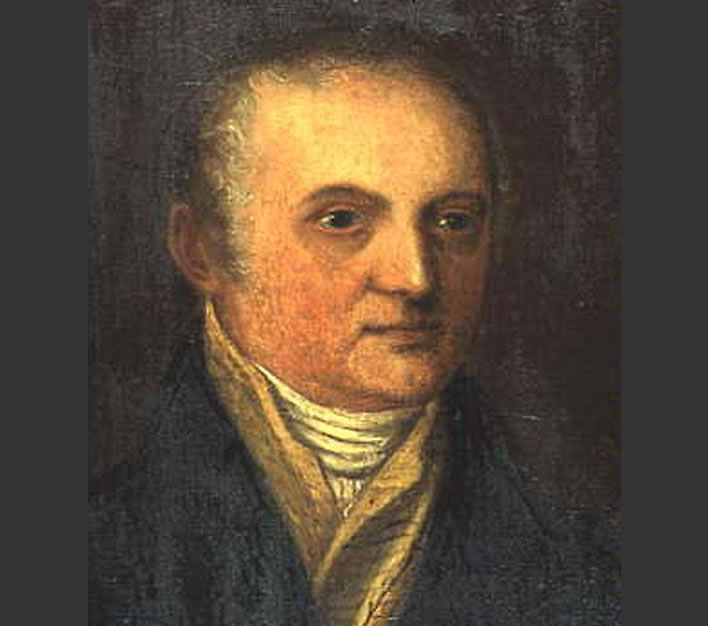
Franz Theodor Schubert. Unknown artist, unknown date.
At his wife's death Franz Theodor was 48. He let the marital bed cool for a decent eleven months before marrying the 29 year-old Anna Kleyenböck on 25 April 1813. No longer the toyboy in the relationship, Franz Theodor appears to have some unfinished business and started producing more babies: Maria Barbara Anna on 22 January 1814, Josefa Theresia on 8 April 1815 and Theodor Kajetan Anton on 15 December of the same year, a babymaking tempo which takes the breath away. Theodor Kajetan lasted only seven months, dying on 30 July 1817. On 7 November 1823 the pair brought another boy into the world, Andreas Theodor, then after another three years one final boy, Anton Eduard, on 3 February 1826. By this time Franz Theodor was 62, Anna 42 and enough was clearly enough. Anna lived on for another 30 years until the Grim Reaper came to call on 25 January 1860.
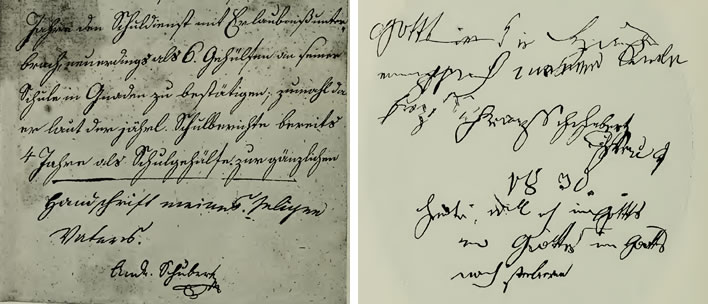
Franz Theodor's handwriting. Left: the schoolteacher's fine hand in 1818. The last two lines are an attestation from his step-brother Andreas Kleyenböck.
Right: his writing in 1830, shortly before his death. Note to young men: this is what happens when you make too many babies – you have been warned!
Partings
After the birth of his last child Franz Theodor had another four years until his death on 9 July 1830. He was buried, at his request, next to Elisabeth, his first wife. The two refugees from the distant Moravian and Silesian countryside had shared a dialect and a background and couldn't keep their hands off each other in the early days before they married.
She, the cook and domestic servant, had skivvied, kept the house and the school, had brought 15 children into the world and borne the misery of the early loss of ten of them. He had escaped from agricultural serfdom and had established himself in the lower bourgoisie of Vienna by work and prudence. He had committed himself to a career of conformist drudgery, for which he had been well-trained by the Jesuits, and had become a well-respected school Principal.
The bond between Elisabeth and Franz Theodor had been strong, there can be no doubt. His brother Karl Schubert, under whose roof they had probably first met, had even married her sister Magdalena Vietz. That bond had carried them both through the darkness of those five terrible years of dead babies, 1788-1793, and it showed itself once more in that last gesture of Franz Theodor, when it mattered: it takes courage to tell your current wife of 17 years to bury you next to your previous wife of 27 years.
By the way, just in case you had forgotten: Franz Theodor and Elisabeth brought forth a musical genius, too, little Franz Peter. Without him they would now be just shadows and footnotes.
Franz Peter's wider horizons
As we have seen, Franz Peter had one big brother, three brothers of similar ages and a little sister. Of course, his immediate siblings were only part of his youthful horizon: After his uncle Karl married his aunt Magdelena, babies started arriving there. Of the seven, only one survived, Maria Magdalena, born 24 August 1797, that is, in the same year as Franz Peter. She and her mother, Elisabeth's younger sister Magdalena, moved in with Franz Theodor and his family after the death of Karl on 29 December 1804. Franz Theodor and his family had close relations with some other families in the district, among them the Grob family, containing Therese, the target of Franz Peter's youthful longings and Heinrich, her musical brother.
It was the Grobs who brought the widower Schubert and Anna Kleyenböck together. From Franz Peter's 16th birthday onwards step-brothers and step-sisters arrived, but we are not surprised to find that, although relations with his step-mother seem to have been as amicable as such relations ever can be, with such a great age-gap, his new siblings seem to play no great part in his life. Franz Theodor and Anna had made a new family.
Enough. The ice is clinking in the glasses as the drinks trolley tours the Figures of Speech editorial offices. Here's to Franz Peter Schubert and the family that made him 220 years ago on the 31st of this month. Cheers!
0 Comments UTC Loaded:
Input rules for comments: No HTML, no images. Comments can be nested to a depth of eight. Surround a long quotation with curly braces: {blockquote}. Well-formed URLs will be rendered as links automatically. Do not click on links unless you are confident that they are safe. You have been warned!